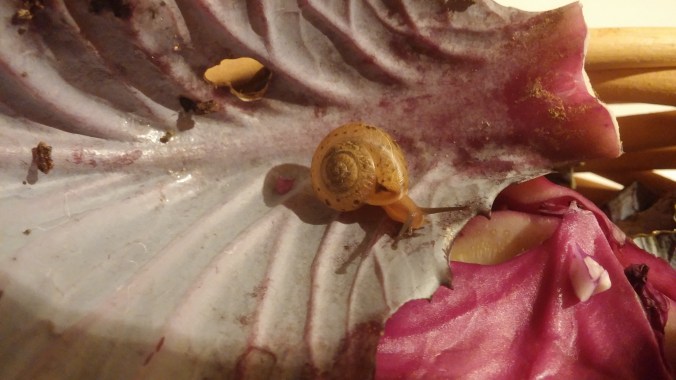Judging by the number of views on my recent Umpteen Salad Dressings post, a fair portion of people like vinegar – or at least don’t mind it. If you like vinegar, pickles, pickled anything, vinegar-y salad dressing and you like beef – any sauerbraten fans out there?? – you just might like Rouladen (pronounced roo-LAH-den). It’s a traditional German dish that any “praktisches Kochbuch” (Practical Cookbook) will include. Here’s mine, published in 1974, a gift from my dear friend Claudia a long time ago!

And in case you are interested, this is the recipe from the book.
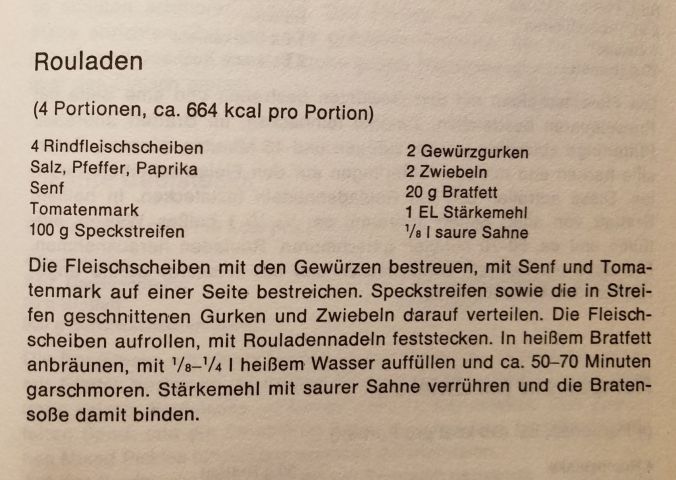
But as you might expect, I do it my way – this time combined with Claudia’s way 😊
I think of these as Assembly Line Rouladen because you get all the innards ready, lay out the thin slabs – let’s call them flats – of beef and systematically sprinkle/spread/place your innards – one at a time – on the flats. Once you’ve got each flat loaded up, you roll them tight, secure each one with a toothpick or two, sear in hot oil, add water and cook until done. If you want, you can then thicken the gravy.
One of the most important things to know about (why) this recipe (tastes so good) is that it contains bacon. As you may well agree, it’s hard to go wrong with bacon. I loved it when the servers at the Bluegrass Grill in downtown Charlottesville wore t-shirts that said “DON’T WORRY – WE HAVE BACON.” They even have bacon jam! Also, their corned beef beats all, but I am going onto a track I did not intend – ah, the power of food! Back to the bacon! Oh, right, back to the rouladen!
I generally use a bottom round cut of beef for recipes that involve slow cooking in liquid (a.k.a. braising), but you will find recipes that say to use top round. I have found that the meat department at my grocery store decides – they pick a cut, slice it thin (1/4-inch) and package it as “Beef for Bracciole” (what you could call the Italian version). Depending on where you live, it might even say For Rouladen. When in doubt, ask the butcher.
The prep for rouladen is like the prep for tacos in that you do the chopping/ preparing/ finding of this and that, put each component in a bowl or a jar or on the counter – get everything ready for assembly – then boom, boom, boom, done! (Okay, maybe there are a few more booms, but you get the idea!) Besides the thinly sliced top or bottom round, you will need mustard, bacon, onions, pickles, carrots, salt and pepper.
Mustard: I like spicy brown mustard, some people prefer Dijon – just use the one you like best.
Bacon: The leaner the better, allow one slice of bacon per piece of beef. I cook mine first to get some of the fat away, and crumble it so that as I spread it on the meat, the flavor is more evenly distributed, but you don’t have to. These will come out just fine if you simply lay the slice of raw bacon on the slab of raw meat and assemble and cook it all together.
Onions: Your call whether to lightly sauté your chopped-up onions in a little bit of olive oil before putting them in. I do because it softens them and makes the beef easier to roll. Approximately one tablespoon of chopped onion per piece of beef. I like onion, so I probably use more than that.
Pickles (dill, not sweet): For ease of spreading, you’ll want to finely chop the pickles or just get/use (pre-chopped) pickle relish, the kind you’d put on a hot dog. Allow a teaspoonful per piece of beef. You use the pickles, not the pickle juice, so try to drain the liquid from them.
Carrots: Hardly essential, but an element of color, nutrition and a tad of sweetness to balance out the vinegar. Claudia suggested adding carrot sticks a few years ago and I love it! Allow 2-4 thin sticks about 3-4 inches long for each.
Salt and Pepper: To taste.
Here are my various innards: You can tell I’m making a lot (24 to be exact) and that I like a lot of onions. My bacon and carrot sticks are in bowls and my pickles are chopped up in the jar.

Lay out the meat on a clean, wide-open surface and put a squiggle of mustard on each one.

Then spread the mustard out, sprinkle with salt and pepper and put a spoonful of pickles on each.
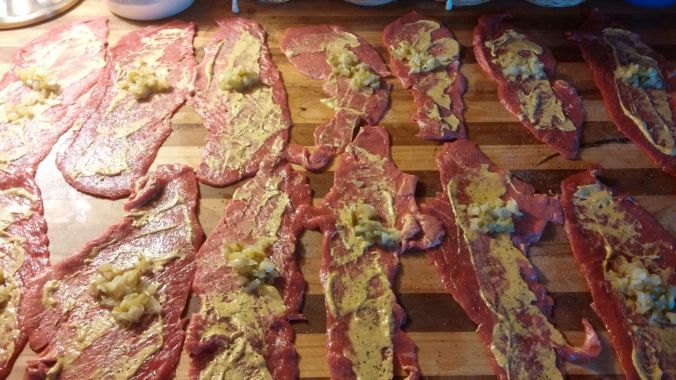
After you spread out the pickles, put a spoonful of onion on each one. Spread out the onion.

Next come the bacon crumbles.
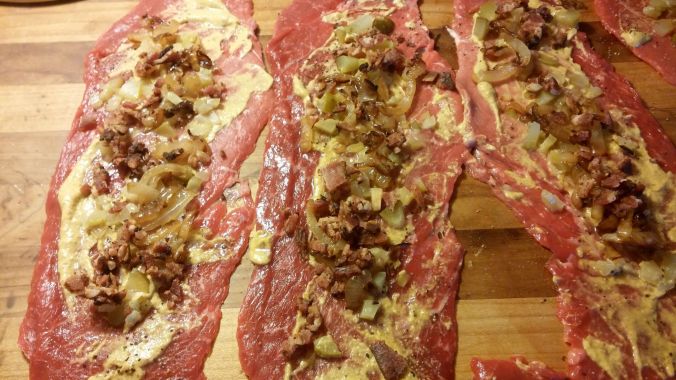
Then the carrots.
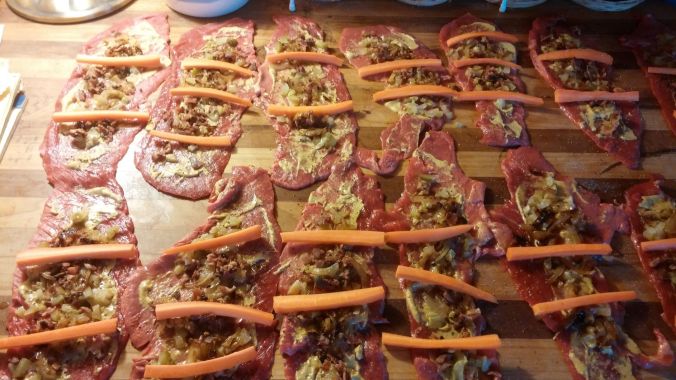
Start at one end of each piece of meat and roll it up carefully, trying to keep all the innards in! Secure with toothpicks.
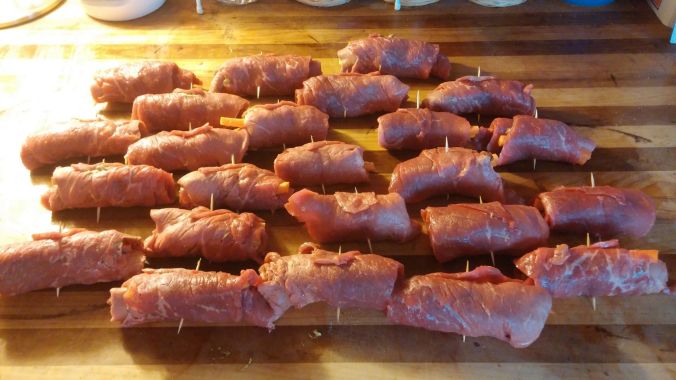
Put a couple tablespoons of olive oil in a good frypan and sear the rollups on a medium-high flame till they are brown most of the way around. Add water to reach about halfway up the sides of the rollups, cover, turn down to a low flame and let cook at a simmer for about an hour.
I like to take them out of the pan, set them in serving dishes, then make the gravy and pour it over top.
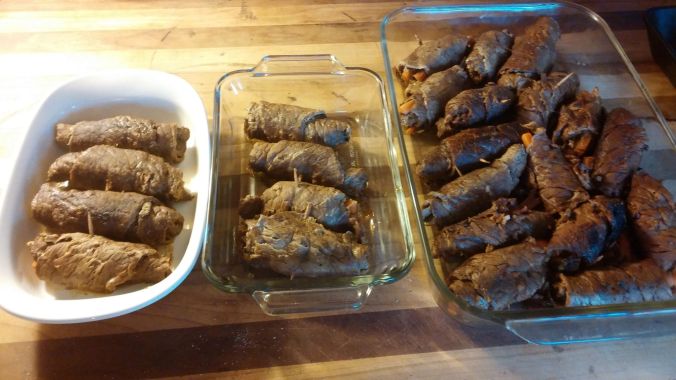
It’s a good idea to take the toothpicks out (this is easier for you than for the person trying to eat it at the table). To make the gravy, figure out how much liquid you have left in the pans by pouring it into a large measuring cup. Then for each cup of liquid you have, melt a tablespoon of butter in a saucepan, whisk in one tablespoon of flour until this is smooth, then add the liquid, whisking gently until it is mixed in and looks like a thin gravy. (The gravy method is easy to remember if you keep it proportional: 1 TBSP butter plus 1 TBSP flour per 1 cup liquid.) Pour gravy over top, cover with foil and keep warm in the oven until ready to serve. These also freeze well.
Very yummy served with egg noodles or spaetzle!!
*One of my favorite parts of the praktisches Kochbuch from Claudia is the title page. In it she wrote “ – KOCHEN MACHT FREUDE – und dasselbe wünsche ich DIR” – “- Cooking brings joy – and this I wish for you.” I love that it’s in her handwriting because that makes it real and personal. I love that it’s fading because that means the gift came long ago and our friendship has grown and flourished all this time. I love that to this day, one of our favorite topics of conversation is what we made for dinner 😊

